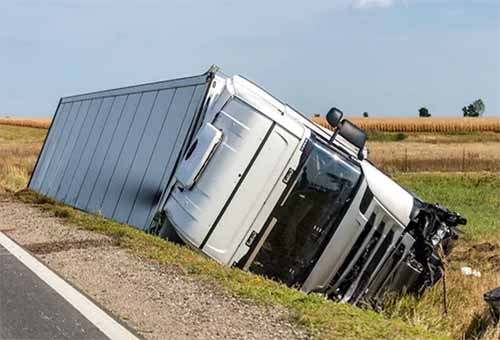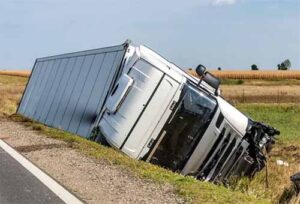
31 Jul Spanish Supreme Court: The compulsory insurance of the truck-tractor does not cover the damage of the semi-trailer towed by it
Reading Time: 6 minutesAccording to the doctrine of the Spanish Supreme Court, damage to the semi-trailer caused by the fault of the truck-tractor´s driver is not covered by the compulsory insurance of the truck-tractor to which was coupled when the accident occurred.
Road-Traffic Accident: Physical Damage on Semi-Trailer
The truck-tractor compulsory insurance does not cover the physical damage caused to the semi-trailer by the fault of the truck-tractor´s driver to which was coupled.
 This judicial decision was issued by the Spanish Supreme Court in a legal dispute between the two insurance companies of the two components of a truck trailer(truck-tractor and semi-trailer) who went out of the road by the fault of the driver.
This judicial decision was issued by the Spanish Supreme Court in a legal dispute between the two insurance companies of the two components of a truck trailer(truck-tractor and semi-trailer) who went out of the road by the fault of the driver.
Once the insurance company of the semi-trailer compensated the insurer for the physical damages that were caused on the semi-trailer, commenced proceedings on court exercising the right to subrogation on the legal action against the insurance of the truck-tractor who caused that accident under the article 43 of the Spanish Insurance Contract Law, to recover the amount paid to the semi-trailer insured.
The claim was rejected in the first instance and estimated on appeal, disputing before the Supreme Court to be determined whether the physical damage caused to the semi-trailer should or should not be covered by the truck-tractor compulsory insurance under article 5.2 of the Law on Civil Liability and Insurance in the Circulation of Motor (hereinafter LRCSCVM) a matter on which there has been conflicting jurisprudence among the Spanish Provincial Courts.
“Whether the final paragraph of Article 3 of Directive 2009/103, read in conjunction with Article 1, points 1 and 2, of that directive, must be interpreted as precluding an interpretation of national legislation which excludes from cover, and therefore from compensation, by compulsory insurance against civil liability in respect of the use of a road truck-tractor, material damage caused by that tractor to the semi-trailer which was coupled to it when the accident occurred, on the ground that, in order for the benefit of their compensation to be granted, that semi-trailer is treated as goods transported by that road tractor or as forming a single vehicle with it.”
The first, second and final paragraph of Article 3 of Directive 2009/103/EC of the European Parliament and of the Council of 16 September 2009 relating to insurance against civil liability in respect of the use of motor vehicles, and the enforcement of the litigation to insure against such liability, read in conjunction with Article 1, points 1 and 2 of that directive, must be interpreted as meaning that they do not preclude an interpretation of national legislation which excludes from cover, and therefore from compensation, by compulsory insurance against civil liability in respect of the use of a road tractor, material damage caused by that tractor to the semi-trailer which was coupled to it when the accident occurred.
However, clarifies:
“The concept of “vehicle” is defined in Article 1, point 1, of Directive 2009/103 as “any motor vehicle intended for travel on land and propelled by mechanical power, but not running on rails, and any trailer, whether or not coupled”.
It´s absolutely clear from the wording of those provisions that both a road tractor and a trailer, or semi-trailer, each taken individually, constitute a “vehicle” within the meaning of that provision, and, consequently, each must, subject to the Member State in which they are normally based exercising the derogation option provided for in Article 5 of that directive, be the subject of a contract concluded with an insurance company in order to cover up the limits established by EU law, civil liability in respect of their use.
As to whether, when a trailer, or a semi-trailer, is coupled to a road tractor, it loses its classification as a “vehicle”, within the meaning of Article 1, point 1, of Directive 2009/103, or whether, when it is coupled to a road tractor, that tractor and that trailer, or semi-trailer, taken together no longer forms one and the same vehicle, within the meaning of that provision, so that the trailer, or semi-trailer, then also falls outside of that classification, it should be pointed out, first, that nothing in the wording of  Article 1, point 1,supports such inferences. The stipulation that trailers, “whether or not coupled”, are covered by the concept of “vehicle”, within the meaning of Article 1, point 1, and the use of the conjunction “and” between the two parts of the definition of that concept clearly indicate that trailers, and semi-trailers, constitute an autonomous category of “vehicle”, within the meaning of that provision, which is distinct from that of “any motor vehicle intended for travel on land and propelled by mechanical power, but not running on rails, of which the classification as such is independent of whether or not it is coupled to another vehicle, within the meaning of that provision.
Article 1, point 1,supports such inferences. The stipulation that trailers, “whether or not coupled”, are covered by the concept of “vehicle”, within the meaning of Article 1, point 1, and the use of the conjunction “and” between the two parts of the definition of that concept clearly indicate that trailers, and semi-trailers, constitute an autonomous category of “vehicle”, within the meaning of that provision, which is distinct from that of “any motor vehicle intended for travel on land and propelled by mechanical power, but not running on rails, of which the classification as such is independent of whether or not it is coupled to another vehicle, within the meaning of that provision.
Secondly, taking the view that, when a trailer, or a semi-trailer, is coupled to a tractor vehicle, it constitutes goods transported by that vehicle or forms a single vehicle with that tractor, and thus loses its specific quality of a “vehicle” within the meaning of Article 1, point 1, of Directive 2009/103, cannot be reconciled with the fact that the definition of the concept of “vehicle”, within the meaning of that provision, is unconnected with the use which is made or may be made of the vehicle concerned and, accordingly, runs counter to that concept being given an objective sense (see, to that effect, judgement of 4 September 2018, Juliana, C-80/17, EU:C:2018:661, paragraphs 38 and 39 and the case-law cited). Nor can that be reconciled with the fact the scope of the obligation to take out insurance against civil liability in respect of the use of motor vehicles must, for reasons of legal certainty, be determined in advance, that is to say, before any involvement of the vehicle concerned in an accident (judgment of 4 September 2018, Juliana, C-80/17, EU:C: 2018:661, paragraph 40).
If a trailer, or a semi-trailer, ceased to be a “vehicle” within the meaning of Article 1, point 1, of Directive 2009/103 when coupled to a tractor vehicle, that would undermine the predictability, stability and continuity of the obligation laid down in the first paragraph of Article 3 of that directive, compliance with which is, however, necessary in order to ensure legal certainty (see, by analogy, judgement of 29 April 2021, Ubezpieczeniowy Fundusz Gwarancyjny, C‑383/19, EU:C:2021:337, paragraph 52).
It fallows that the finding that, when a trailer, or a semi-trailer, is coupled to a road tractor, it constitutes goods transported by that road tractor or forms a single vehicle with that tractor, and thus ceases to be a “vehicle” within the meaning of Article 1, point 1, of Directive 2009/103, cannot be compatible with that provision. Consequently, subject to the Member State in which the trailer, or semi-trailer, concerned is normally based exercising the option granted to it by Article 5 of Directive 2009/103, any trailer, or semi-trailer, falls under the insurance obligation laid down in the first paragraph of Article 3 of Directive 2009/103, whether or not is coupled to another vehicle.”
The Spanish Supreme Court establishes that under the Article 5.2. LRCSCVM, the compulsory insurance against civil liability coverage excludes from cover, and therefore from compensation, the damage to the goods transported by that road tractor or owned by the that insurance policyholder, insured person, owner or driver, but also spouse o relative up to third degree of consanguinity or affinity of the above persons, article that according to the Court of Justice of the European Union is not contrary to the Directive 2009/103/CE – as the truck-tractors does not have capacity or own ability to transport “goods”, both the semi-trailer, which is not propelled by mechanical power, as its load, must be considered, in cases such as this, “goods transported by the truck-tractor” within the meaning of the coverage exclusion under the article 5.2 LRCSCVM.
Thus, the Supreme Court reiterates its case law stablished on its Judgment nº 246/1996, of April 1stunder which “the truck-tractor which, by its own physical structure cannot carry “goods”, its sole function is to tow the trailer or the semi-trailer who contains the goods carried, so in strict and elementary logic, has to be understood that what the truck-tractor carries are not just the cargo contained inside the trailer, but also the trailer, as the two elements (continent and content)form, for this purpose, one whole”, a rule that as can be noted may conflict with the judgement of the Court of Justice of the European Union that establishes that a trailer when it is coupled to the truck-tractor does not loses its classification as a vehicle.
